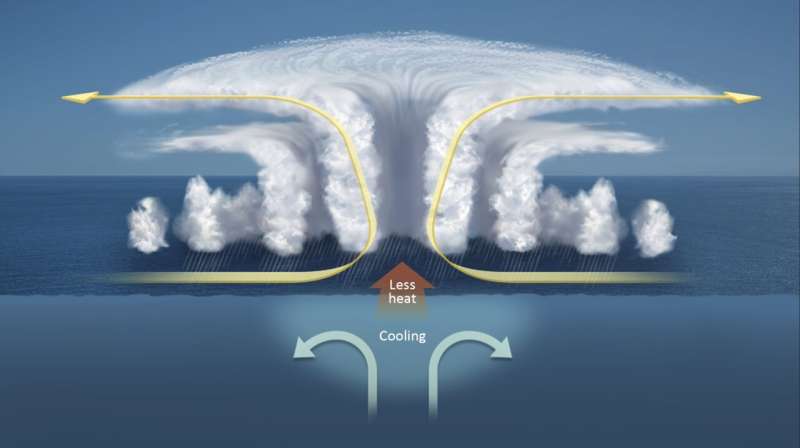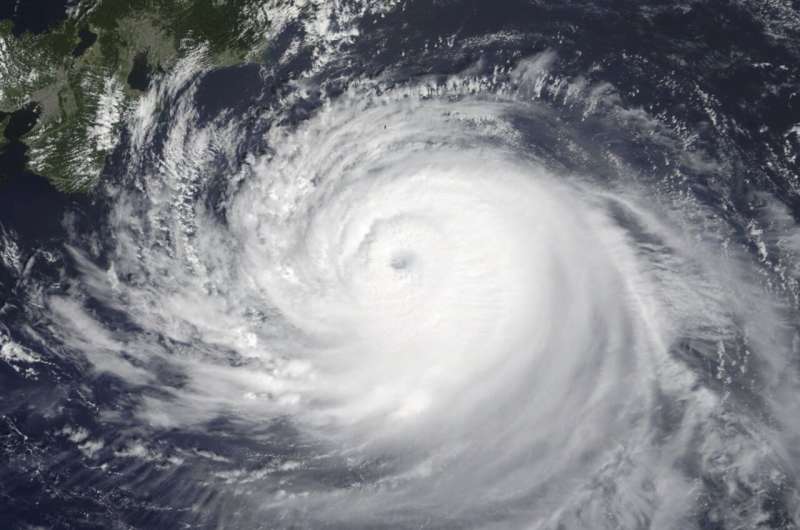This article has been reviewed according to Science X's editorial process and policies. Editors have highlighted the following attributes while ensuring the content's credibility:
fact-checked
peer-reviewed publication
trusted source
proofread
Global warming found to have a bigger effect on compact, fast-moving typhoons

A research group from Nagoya University in Japan has found that larger, slower-moving typhoons are more likely to be resilient against global warming. However, compact, faster-moving storms are more likely to be sensitive. These findings suggest an improved method to project the strength of typhoons under global warming conditions. The report is published in Geophysical Research Letters.
Tropical cyclones are among the most dangerous weather systems in the world, causing disruption, damage, and death in East Asia. As global temperatures increase, so does the threat of typhoons. But projecting the strength and structure of such storms also becomes more difficult. Understanding changes in ocean response is essential to mitigate the worst effects of typhoons.
One way to understand tropical cyclones is to examine the relationship between the atmosphere and the ocean. The ocean–atmosphere coupling relationship influences weather patterns, ocean circulation, and climate variability.
This is especially important for typhoons as the intensity of tropical cyclones is linked to increases in sea surface temperature (SST). As the size of a cyclone increases, SST decreases, limiting its intensity. However, under global warming, the SST is higher. As a result, this could make a typhoon last longer.
"The rise in sea temperatures is concerning because a typical compact, fast-moving storm—for example, Typhoon Faxai in 2019—caused severe damage to eastern Japan," warned lead researcher Sachie Kanada. "Our findings show the intensity of such typhoons can strengthen under global warming conditions."

To understand how global warming can affect typhoons, Kanada and fellow researcher Hidenori Aiki examined the buffering effect of atmosphere-ocean coupling on typhoons. They used the latest simulator of weather systems, an atmosphere-ocean model called CReSS-NHOES, to evaluate the effect of atmosphere ocean coupling on changes in the intensity of strong typhoons. CReSS-NHOES combines the cloud simulation model CReSS, developed at Nagoya University, with the oceanographic model NHOES, developed by the Japan Agency for Marine-Earth Science and Technology.
The researchers used CReSS-NHOES to examine four powerful but different-sized typhoons in recent years: Trami (2018), Faxai (2019), Hagibis (2019), and Haishen (2020). These typhoons were all devastating; Trami and Faxai caused billions of dollars of damage and Hagibis led to the deaths of 118 people.
Kanada and Aiki evaluated three scenarios: preindustrial era climate, a 2° C increase in SST, and a 4° C increase in SST.
"We found that the degree to which typhoons strengthened per 1° C rise in SST varies significantly from typhoon to typhoon," said Kanada.
She was surprised by the change in hPa, a unit of pressure used in meteorology to measure atmospheric pressure and which represents the strength and intensity of a storm, and noted, "A typhoon such as Trami strengthens by only 3.1 hPa, while Faxai strengthens by as much as 16.2 hPa with a 1° C rise in SST."
The results of this study suggest that the atmosphere-ocean coupling effect buffers changes in storm intensity associated with global warming. But typhoons of different sizes may be affected differently. Storms with large eyes and small movement speeds cause SST to drop near their center, hindering their development. However, storms with small eyes and high movement speeds move away from the SST occurrence. Such typhoons maintain constant heat at their center, increasing in intensity.
Using these findings, the researchers created a new model to project the effect of tropical cyclones. They used a simple parameter called nondimensional storm speed (S0). Their model showed that S0 could distinguish between potentially destructive storms that are likely to strengthen under global warming and those that are resilient to the effects of global warming.
"Currently, climate change projection research on typhoon intensity is conducted using models with coarse horizontal resolution or atmosphere-only models, which have difficulty reproducing the intensity and structure of strong typhoons," Kanada explains.
"This research using a high-resolution coupled regional atmosphere-ocean model can reproduce the intensity and structure of strong typhoons and the response of the ocean with high accuracy, so is expected to contribute not only to the quantitative projection of typhoon intensity under a warming climate, but also to the improvement of the accuracy of current typhoon intensity forecasts."
More information: S. Kanada et al, Buffering Effect of Atmosphere–Ocean Coupling on Intensity Changes of Tropical Cyclones Under a Changing Climate, Geophysical Research Letters (2023). DOI: 10.1029/2023GL105659
Journal information: Geophysical Research Letters
Provided by Nagoya University




















